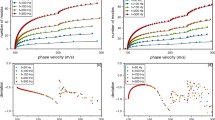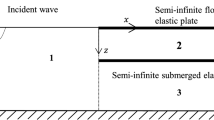Abstract
The article presents a numerical study of the formation of the amplitude response in a free surface from simultaneous scattering of Rayleigh waves and vertically incident longitudinal waves by an embedded contrast velocity inclusion. It has been established that the significant presence of body waves in a microseismic field does not fundamentally change the result of the microseismic sounding method, which is based on the notion of the overwhelming contribution of the fundamental mode of a Rayleigh wave to the formation of the Earth’s microseismic field. Cases are considered when a microseismic signal at the same frequency is modeled only by the fundamental mode of the Rayleigh wave, only by a vertically incident longitudinal wave, and by both types of waves simultaneously. Variants of inhomogeneities with different dimensions and velocity properties are considered. The analysis was performed in a (λ, r)-space, in analogy with reconstruction of the structure of the geological setting in the microseismic sounding method, where λ is the wavelength of the fundamental Rayleigh mode and r is the coordinate on the Earth’s surface.



Similar content being viewed by others
REFERENCES
A. V. Gorbatikov and A. A. Tsukanov, Phys. Solid Earth 47 (4), 354 (2011).
A. A. Tsukanov and A. V. Gorbatikov, Izv., Phys. Solid Earth 51 (4), 548 (2015).
A. V. Gorbatikov, M. Yu. Stepanova, and G. E. Korablev, Phys. Solid Earth 44 (7), 577 (2008).
Y. Nakamura, Q. Rep. Railw. Tech. Res. Inst. 30 (1), 25 (1989).
L. P. Vinnik, A. S. Deniskov, and T. D. Kon’kov, Izv. Akad. Nauk SSSR, Fiz. Zemli, No. 8, 21 (1967).
L. P. Vinnik, Structure of Microseisms and Some Problems on Grouping Procedure for Seismology (Nauka, Moscow, 1968) [in Russian].
J. F. Claerbout, Geophysics 29 (2), 197 (1964).
P. Gerstoft, M. C. Fehler, and K. G. Sabra, Geophys. Res. Lett. 33, L17308 (2006). https://doi.org/10.1029/2006GL027270
P. Gerstoft, P. M. Shearer, N. Harmon, and J. Zhang, Geophys. Res. Lett. 35, L23306 (2008). https://doi.org/10.1029/2008GL036111
K. D. Koper and B. De Foy, Bull. Seismol. Soc. Am. 98 (6), 3033 (2008).
M. Landes, F. Hubans, N. M. Shapiro, A. Paul, and M. Campillo, in Proc. AGU Fall Meeting (San Francisco, CA, 2008), Vol. 1, p. 1893.
T. B. Yanovskaya, Phys. Solid Earth 53 (6), 819 (2017).
W. Menke, Geophysical Data Analysis: Discrete Inverse Theory (Academic Press, 2012), Vol. 45.
R. A. Wiggins, Rev. Geophys. 10 (1), 251 (1972).
K. Aki and P. G. Richards, Quantitative Seismology, Theory and Methods (W. H. Freeman, San Francisco, CA, 1980; Mir, Moscow, 1983), Vol 1.
A. I. Lur’e, Theory of Elasticity (Nauka, Moscow, 1970) [in Russian].
I. A. Viktorov, Rayleigh and Lamb Waves: Physical Theory and Applications (Plenum Press, New York, 1967).
P. G. Malischewsky, Wave Motion 31 (1), 93 (2000).
Kalitkin, N.N., Numerical Methods (Nauka, Moscow, 1978) [in Russian].
A. A. Tsukanov, Candidate’s Dissertation in Mathematics and Physics (Moscow State Univ., Moscow, 2010).
A. A. Tsukanov and A. V. Gorbatikov, in Proc. Geomodel 2016–18th Science and Applied Research Conference on Oil and Gas Geological Exploration and Development (Gelendzhik, 2016). http://www.earthdoc.org/publication/publicationdetails/?publication=86769. https://doi.org/10.3997/2214-4609.201602198
A. A. Tsukanov and A. V. Gorbatikov, Acoust. Phys. 64 (1), 70 (2018).
V. Sadovnichy, A. Tikhonravov, Vl. Voevodin, and V. Opanasenko, in Contemporary High-Performance Computing: From Petascale toward Exascale. Chapman and Hall/CRC Computational Science (CRC Press, Boca Raton, FL, 2013), p. 283.
A. V. Adinets, P. A. Bryzgalov, V. V. Voevodin, S. A. E. Zhumatii, D. A. Nikitenko, and K. S. Stefanov, Numer. Methods Program. Adv. Comput. 13 (4), 160 (2012).
Author information
Authors and Affiliations
Corresponding authors
Rights and permissions
About this article
Cite this article
Tsukanov, A.A., Gorbatikov, A.V. Influence of the Contribution of Body Waves to the Result of the Microseismic Sounding Method. Acoust. Phys. 66, 191–197 (2020). https://doi.org/10.1134/S106377102001011X
Received:
Revised:
Accepted:
Published:
Issue Date:
DOI: https://doi.org/10.1134/S106377102001011X




